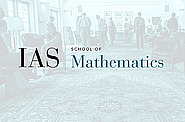Seminars Sorted by Series
Computer Science/Discrete Mathematics Seminar II
Nov
27
2018
Computer Science/Discrete Mathematics Seminar II
Monotone Circuit Lower Bounds from Resolution
10:30am|Simonyi Hall 101
Dec
04
2018
Computer Science/Discrete Mathematics Seminar II
No Seminar (Simons workshop Berkeley)
10:30am|No Seminar (Simons workshop Berkeley)
Dec
11
2018
Computer Science/Discrete Mathematics Seminar II
An invitation to tensor networks
Michael Walter
10:30am|Simonyi Hall 101
Jan
22
2019
Jan
29
2019
Computer Science/Discrete Mathematics Seminar II
A Regularity Lemma with Modifications
10:30am|Simonyi Hall 101
Feb
05
2019
Computer Science/Discrete Mathematics Seminar II
Non-commutative rank
Visu Makam
10:30am|Simonyi Hall 101
Feb
12
2019
Computer Science/Discrete Mathematics Seminar II
Why can't we prove tensor rank and Waring rank lower bounds?
Visu Makam
10:30am|Simonyi Hall 101
Feb
19
2019
Feb
26
2019
Mar
05
2019
Computer Science/Discrete Mathematics Seminar II
Improved List-Decoding and Local List-Decoding Algorithms for Polynomial Codes
10:30am|West Building Lecture Hall
Mar
12
2019
Computer Science/Discrete Mathematics Seminar II
Halting problems for sandpiles and abelian networks
10:30am|Simonyi Hall 101
Mar
19
2019
Computer Science/Discrete Mathematics Seminar II
A Brief Tour of Proof Complexity: Lower Bounds and Open Problems
10:30am|Simonyi Hall 101
Mar
26
2019
Computer Science/Discrete Mathematics Seminar II
Factors of sparse polynomials: structural results and some algorithms
10:30am|Simonyi Hall 101
Apr
02
2019
Computer Science/Discrete Mathematics Seminar II
A high-dimensional Littlewood--Offord inequality
Li-Yang Tan
10:30am|Simonyi Hall 101
Nov
05
2019
Computer Science/Discrete Mathematics Seminar II
Extremal set theory
Andrey Kupavskii
10:30am|Simonyi Hall 101
Nov
19
2019
Computer Science/Discrete Mathematics Seminar II
Constraint Satisfaction Problems and Probabilistic Combinatorics I
Fotios Illiopoulos
10:30am|Simonyi Hall 101
Nov
26
2019
Computer Science/Discrete Mathematics Seminar II
Constraint Satisfaction Problems and Probabilistic Combinatorics II
Fotios Illiopoulos
10:30am|Simonyi Hall 101
Dec
03
2019
Computer Science/Discrete Mathematics Seminar II
Regularity lemma and its applications Part I
10:30am|Simonyi Hall 101
Dec
10
2019
Dec
17
2019
Computer Science/Discrete Mathematics Seminar II
Permutation property testing
10:30am|Simonyi Hall 101
Jan
21
2020
Computer Science/Discrete Mathematics Seminar II
Approximating CSPs on expanding structures, and applications to codes
10:30am|Simonyi Hall 101
Jan
28
2020
Computer Science/Discrete Mathematics Seminar II
Pseudo-deterministic algorithms
10:30am|Simonyi Hall 101
Feb
04
2020
Computer Science/Discrete Mathematics Seminar II
Proofs, Circuits, Communication, and Lower Bounds in Complexity Theory
10:30am|Simonyi Hall 101
Feb
11
2020
Computer Science/Discrete Mathematics Seminar II
Proofs, Circuits, Communication, and Lower Bounds in Complexity Theory
Robert Robere
10:30am|Simonyi Hall 101
Feb
18
2020
Computer Science/Discrete Mathematics Seminar II
An invitation to invariant theory
10:30am|Simonyi Hall 101
Feb
25
2020
Computer Science/Discrete Mathematics Seminar II
Is the variety of singular tuples of matrices a null cone?
10:30am|Simonyi Hall 101
Feb
27
2020
Computer Science/Discrete Mathematics Seminar II
Spectral Independence in High-dimensional Expanders and Applications to the Hardcore Model
Kuikui Liu
2:30pm|Simonyi Hall 101
Mar
03
2020
Computer Science/Discrete Mathematics Seminar II
An introduction to Boolean Function Analysis
Dor Minzer
10:30am|Simonyi Hall 101
Mar
10
2020
Computer Science/Discrete Mathematics Seminar II
Introduction to high dimensional expanders
10:30am|Simonyi Hall 101
Mar
17
2020
Computer Science/Discrete Mathematics Seminar II
Sharp Thresholds and Extremal Combinatorics
Dor Minzer
10:30am|https://theias.zoom.us/j/360043913
Mar
24
2020
Computer Science/Discrete Mathematics Seminar II
High dimensional expansion and agreement testing
10:30am|https://theias.zoom.us/j/360043913
Mar
31
2020
Computer Science/Discrete Mathematics Seminar II
High dimensional expansion and agreement testing
10:30am|https://theias.zoom.us/j/360043913
Apr
07
2020
Computer Science/Discrete Mathematics Seminar II
Primality testing
Andrey Kupavskii
10:30am|https://theias.zoom.us/j/360043913
Apr
21
2020
Computer Science/Discrete Mathematics Seminar II
Non-commutative optimization: theory, algorithms and applications (or, can we prove P!=NP using gradient descent)
10:30am|https://theias.zoom.us/j/360043913
Apr
28
2020
Computer Science/Discrete Mathematics Seminar II
A Framework for Quadratic Form Maximization over Convex Sets
10:30am|https://theias.zoom.us/j/360043913
May
05
2020
Computer Science/Discrete Mathematics Seminar II
Recent Progress on Cutting Planes Proofs
Noah Fleming
10:30am|https://theias.zoom.us/j/360043913
May
12
2020
Computer Science/Discrete Mathematics Seminar II
Convex Set Disjointness, Distributed Learning of Halfspaces, and Linear Programming
10:30am|https://theias.zoom.us/j/360043913
Sep
29
2020
Computer Science/Discrete Mathematics Seminar II
An introductory survey on expanders and their applications
10:30am|Simonyi Hall 101 and Remote Access - see Zoom link below
Oct
06
2020
Computer Science/Discrete Mathematics Seminar II
Simplified Lifting Theorems in Communication Complexity via Sunflowers
10:30am|Simonyi Hall 101 and Remote Access - see Zoom link below
Oct
13
2020
Computer Science/Discrete Mathematics Seminar II
Arithmetic progressions and spectral structure
Thomas Bloom
10:30am|Simonyi Hall 101 and Remote Access - see Zoom link below
Oct
20
2020
Computer Science/Discrete Mathematics Seminar II
The threshold for the square of a Hamilton cycle
10:30am|Remote Access - see Zoom link below
Oct
27
2020
Computer Science/Discrete Mathematics Seminar II
On the extension complexity of random polytopes
10:30am|Simonyi 101 and Remote Access
Nov
10
2020
Computer Science/Discrete Mathematics Seminar II
Modular zeros in the character table of the symmetric group
10:30am|Remote Access Only - see link below
Nov
17
2020
Computer Science/Discrete Mathematics Seminar II
Factorization through L2, Rounding and Duality
10:30am|Simonyi Hall 101 and Remote Access - see Zoom link below
Nov
24
2020
Computer Science/Discrete Mathematics Seminar II
Factorization through L2, Rounding and Duality Part 2
10:30am|Remote Access Only - see link below
Dec
01
2020
Computer Science/Discrete Mathematics Seminar II
Getting the most from our data
10:30am|Simonyi Hall 101 and Remote Access - see Zoom link below
